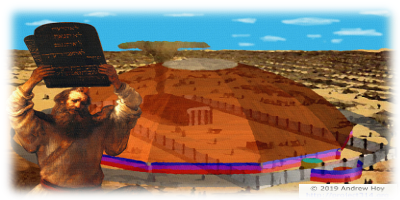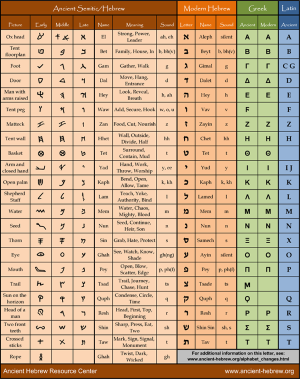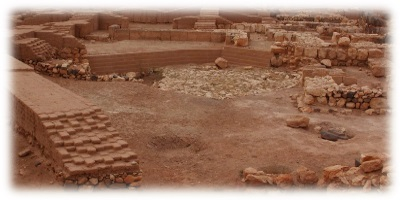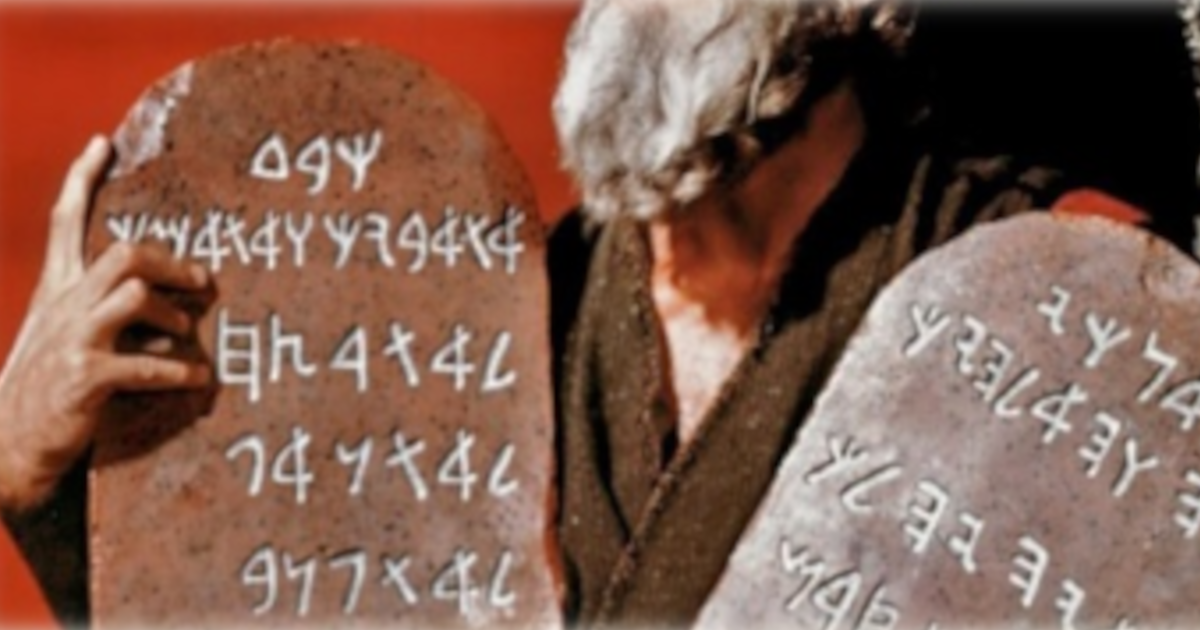All that being said, how are the Hebrew אהל and משׁכן terms to be distinguished in English, or more specifically, how is the  phrase, to be understood? Based upon usage,
phrase, to be understood? Based upon usage,  is predominantly translated as “the tabernacle” (a.k.a. the unique “Tent of Meeting”) throughout the Bible. Also, with the Hebrew definite article ה or “the” preceding “tabernacle”, it stands to reason that it might be regarded as a proper noun, perhaps best rendered as “the Tabernacle”. However, this is not to say that “Tabernacle” is a good choice of words in translation, either. After all, the Latin root “Taberna”, from which “Tabernacle” (and the English “Tavern”) is derived, is often used to describe shack or hut, even though the Hebrew משׁכן or “mishkan” term (from H7931) is more literally rooted in the action of dwelling or residing and therefore is a term that is not associated with a particular construction style. Thus, a “mishkan” is best understood in English vernacular more generically, as a residence or a dwelling place, especially as the term “Tabernacle” is practically never used in everyday conversation unless the term is coupled to something that is religious in nature. Taken literally, the Hebrew
is predominantly translated as “the tabernacle” (a.k.a. the unique “Tent of Meeting”) throughout the Bible. Also, with the Hebrew definite article ה or “the” preceding “tabernacle”, it stands to reason that it might be regarded as a proper noun, perhaps best rendered as “the Tabernacle”. However, this is not to say that “Tabernacle” is a good choice of words in translation, either. After all, the Latin root “Taberna”, from which “Tabernacle” (and the English “Tavern”) is derived, is often used to describe shack or hut, even though the Hebrew משׁכן or “mishkan” term (from H7931) is more literally rooted in the action of dwelling or residing and therefore is a term that is not associated with a particular construction style. Thus, a “mishkan” is best understood in English vernacular more generically, as a residence or a dwelling place, especially as the term “Tabernacle” is practically never used in everyday conversation unless the term is coupled to something that is religious in nature. Taken literally, the Hebrew  or “the Mishkan” is referring not to “a shack”, but rather a particular dwelling place.
or “the Mishkan” is referring not to “a shack”, but rather a particular dwelling place.

As for the preceding  phrase, given the confusion imposed by translators upon “cover”, “tent”, and “tabernacle” usages, it is most fitting to consider the אהל term relative to physical descriptions of the curtains themselves. As illustrated in the round Tabernacle image below, the eleven wool curtain strips measuring 30 x 4 cubits are all designed to be connected short-edge-to-short edge, and are equipped with loops on opposite ends, with one curtain folded in half, and collectively overlapping one cubit. From this description, as well as from the math, the audience should understand that the final shape will be cylindrical (because all curtains must connect to an adjacent one to comply with the Bible description), and because the final circumferential dimensions measure 314 cubits—which is a clear and obvious hint of π. Understanding that the curtain assembly would logically be assembled on by people bound by gravity to a horizontal ground plane, deductive reasoning dictates that the curtains “over” or על the dwelling place would more specifically be installed “around” the dwelling place, especially as the dwelling place itself is formed in part by an assembly of ten colored linen curtains, each measuring only 28 x 4 cubits (Exodus 26:1), which would obviously create a smaller tent perimeter.
phrase, given the confusion imposed by translators upon “cover”, “tent”, and “tabernacle” usages, it is most fitting to consider the אהל term relative to physical descriptions of the curtains themselves. As illustrated in the round Tabernacle image below, the eleven wool curtain strips measuring 30 x 4 cubits are all designed to be connected short-edge-to-short edge, and are equipped with loops on opposite ends, with one curtain folded in half, and collectively overlapping one cubit. From this description, as well as from the math, the audience should understand that the final shape will be cylindrical (because all curtains must connect to an adjacent one to comply with the Bible description), and because the final circumferential dimensions measure 314 cubits—which is a clear and obvious hint of π. Understanding that the curtain assembly would logically be assembled on by people bound by gravity to a horizontal ground plane, deductive reasoning dictates that the curtains “over” or על the dwelling place would more specifically be installed “around” the dwelling place, especially as the dwelling place itself is formed in part by an assembly of ten colored linen curtains, each measuring only 28 x 4 cubits (Exodus 26:1), which would obviously create a smaller tent perimeter.
Likewise, to infer that על, which is reasonably translated as “upon”, conveys that the tent is situated “up-on” (i.e., “above” or “on top of”) the dwelling place is presumptive as it is illogical, especially if the curtains are “to cover” or “to tent” over the residence. After all, the Hebrew preposition על for “over” or “upon” works much like the English counterparts, whereby they are not necessarily describing a relative elevation or vertical relationship, but rather a relative positioning. For example, a shirt worn “over” the body is not worn on top of the head as a hat, as the shirt is designed to surround and encompass. Furthermore, this notion of the wool curtains forming a vertical courtyard barrier at ground level is further reinforced by the Hebrew reference to על צדי המשכן in Exodus 26:13, which distinctly indicates that the eleven curtains are to be installed “over/around the Tabernacle side”, as opposed to “over/upon the Tabernacle top”.
As I reflect back upon my Hebrew journey which began over a decade ago, I recall what a strange and unexpected joy it was to learn the alphabet—or more specifically, the Hebrew “aleph-bet”—from scratch as an adult. While the foreign letters were unfamiliar and thus a little intimidating at first, I found it was pretty easy to learn the names of the twenty-two Hebrew letters—especially if they were put to a simple and catchy “aleph-bet” tune. Likewise, learning the phonics associated with the each of the letters also came pretty easy, as most of the Hebrew letters bear obvious similarities to an English alphabet counterpart. Coupling the sights and sounds of the Hebrew characters together, I had mapped all of them into my mind in just a couple of weeks. In fact, it seemed as if the letters were somehow already familiar—perhaps embedded into the very core of my DNA since my conception.
While I was under the impression that I had ancient aleph-bet system down in just a few weeks, in hindsight, I’m now compelled to admit that I did not scarcely understand the Hebrew aleph-bet until I discovered Jeff Benner’s Ancient Hebrew Resource Center alphabet chart several years later. While I’m a little embarrassed to confess that I didn’t come to appreciate the significance of Jeff’s paleo-Hebrew language the first time that I encountered it, I will now say with conviction that the Ancient Hebrew Resource Center (AHRC) alphabet chart is something that I’ll never forget.
To no fault of anyone, I would surmise that others familiar with the ancient Hebrew aleph-bet might have a testimony that is similar to my own. From my personal experience, the first time I saw Jeff’s AHRC chart, I thought I was looking at something more like Egyptian hieroglyphs than ancient Hebrew letters. But as I began to consider the “big picture” idea—that the ancient Hebrew characters were actually pictographs that conveyed both physical objects and action-based meanings—the language’s foundation came into focus, and the overall premise began to make a lot of sense. Once I came to understand how the ancient letters used to spell Hebrew root words can broken down and linked together to form abbreviated sentences that in turn define and/or shed further light on the Hebrew terms, I became both amazed and inspired.
While a number of professional linguists are openly skeptical and seem to be eager to cast a dark shadow of doubt over early Semitic aleph-bets and Mr. Benner’s work, presuming it to be speculative and contradictory to the “scientific” methods and results accepted by academia at large, I am writing this article to offer testimony in favor of Jeff’s findings. As a result of my own Exodus Tabernacle discovery (project314.org) and independent Bible research, I find the bulk of Jeff’s AHRC research to be not only complementary to information provided in the existing ancient lexicons, but also as an invaluable supplementary tool for study of the Hebrew Bible.
Discovering the Ancient Hebrew Dwelling Place
Before I elaborate on how Jeff’s AHRC work relates to my Tabernacle studies, it is important that the reading audience possess some understanding of my Exodus discovery and research. For those unaware, I am a mechanical engineer, and I have specialized in Exodus Tabernacle research since rediscovering it in 2014. Although I cannot offer archaeological evidence or physical tent remains to substantiate my claim, I nevertheless profess without doubt or apology that I have deciphered the original design of the ancient Tabernacle structure from the pages of the Exodus texts—and that the ancient “Tent of Meeting” is nothing like the rectangular abomination that religious traditions put forth for us believe. Instead, Moses recorded plans to a tent that was unequivocally round—a yurt-like structure that towered perhaps six stories over the plains of the Sinai wilderness.
While religious traditionalists who are scarcely familiar with the English Exodus account might be quick to dismiss or outright scoff at the notion of a round Exodus Tabernacle, there is nevertheless an abundance of evidence to support and fully endorse the conclusion. First and foremost, a number of simple proofs can be found in courtyard curtain description, as outlined in Exodus 26:
And thou shalt make curtains of goats' hair to be a covering upon the tabernacle: eleven curtains shalt thou make. The length of one curtain shall be thirty cubits, and the breadth of one curtain four cubits: and the eleven curtains shall be all of one measure. And thou shalt couple five curtains by themselves, and six curtains by themselves, and shalt double the sixth curtain in the forefront of the tabernacle. And thou shalt make fifty loops on the edge of the one curtain that is outmost in the coupling, and fifty loops in the edge of the curtain which coupleth the second. And thou shalt make fifty taches of brass, and put the taches into the loops, and couple the tent together, that it may be one. And the remnant that remaineth of the curtains of the tent, the half curtain that remaineth, shall hang over the backside of the tabernacle. And a cubit on the one side, and a cubit on the other side of that which remaineth in the length of the curtains of the tent, it shall hang over the sides of the tabernacle on this side and on that side, to cover it. (Exodus 26:7-13, KJV)
In this short Exodus excerpt, eleven narrow curtains measuring 30 x 4 cubits are described–each curtain being equipped with fifty loops at opposite sides for interconnection with an adjacent curtain. Nevertheless, these curtains are traditionally assumed to be joined at the long edges, such that a 30 x 42 rectangular swatch is made (see illustration below). Unfortunately, this approach not only fails to connect all of the curtain edges, but it also connects the curtains on the improper edges. To the contrary, the Bible text indicates that curtains are to be connected on the “outmost” edges, or sometimes interpreted as the “outermost” (i.e., farthest reaching) edges, or as more literally translated from the Hebrew, the “cut” edges (loom-woven fabric strips are cut to length [warp], whereas the width dimensions [weft] are fixed during setup with edges created by a continuous and uncut cross thread). Thus, the eleven curtains have loops woven in at opposite edges for interconnection with an adjacent one, thereby making the curtains joined in such a way such that they form a cylinder.
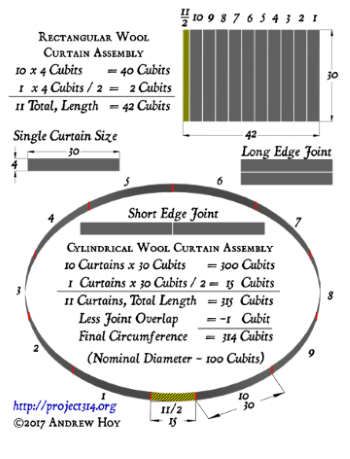
Perhaps of equal importance—but of greater inspiration—are the dimensions of the final assembly. As the eleven curtains measuring 30 cubits long are joined together at the short 4 cubit edge, they would create a long circumferential strip measuring 330 cubits; however, folding the last of the eleven curtains in half (reducing the length from 30 cubits to 15 cubits per Exodus 26:9&12) results in assembled length of 315, and subtracting one cubit (accounting for the overlapping of end joints per Exodus 26:13), would make the final courtyard or “tent” dimension measure exactly 314 cubits. As 314 is a near perfect multiple of π—the mathematical constant that conveys the ratio between a circle’s circumference and its diameter—the dimensions hint to the final shape being round. As indicated above, a cylinder is the logical outworking of connecting a set of rectangular fabric strips together end-to-end—given that the last two joints on the opposite edges of the strips are not left disconnected or open ended.
Upon making this π discovery, it was intuitive and logical to propose a round Tabernacle hypothesis. Consequentially, upon further examination, I quickly came to understand how nearly every verse of the Tabernacle narrative testifies to this fact–that Exodus was describing an enormous and majestic domed tent, which has been “lost in translation” and misrepresented by religious traditions for thousands of years. Convinced that I had rediscovered the “key to God’s House” by finding π in the Exodus text, I founded project314.org in order to further research and public understanding of the so-called “Tabernacle” of Moses, which understood from the Hebrew to be God’s “Mishkan” or “dwelling place”.
As I am a professional engineer (as opposed to theologian) by training, it seems that the public has responded to my unprecedented Tabernacle discovery claim in a variety of different ways. After making the discovery known to the public, I was shocked to find that most people—religious professionals included—would not investigate the claim for themselves based on the simple and straightforward 314 discovery alone (the π ratio can also be found within letters of the Hebrew Genesis and the language of Solomon’s Temple description in the book of kings). To my dismay, it seemed that few had the inclination, aptitude, incentive, or the confidence in my round Tabernacle claim to embark upon an independent investigation. While some have accepted the round tent discovery based upon a mixture of blind faith and practical reasoning, many remain skeptical nevertheless as they continue to operate in a mode of “learned helplessness”. Ironically, it seems that people have more faith in deceased or familiar theologians who have presumed to understand a structural description embedded in religious texts than they have confidence in unknown engineers expounding upon the exacting technical aspects of the same sacred texts. Furthermore, because the end result of my translation is so radically different relative to the religious norm, skeptics are compelled to find strength in numbers and consequentially feel justified in ignoring the one single data point that is so far off the curve—regardless of the merits of the technical arguments, the similarities to ancient or nomadic architecture, or the actual Hebrew etymology and translation methods that I used to arrive at the round Tabernacle conclusion.
Ancient Hebrew Tent Analysis and Exegesis Results
Being inundated and indoctrinated by Bible-esque artwork since their youth, most religious people are quick to conjure images of a long rectangular Tabernacle, which is nested within a large rectangular courtyard with a simple 2:1 aspect ratio. For the few who are curious enough to briefly entertain my round courtyard claim, they open their English Bibles to the otherwise unfamiliar 27th chapter of Exodus and skim to the part that mentions a court that measures 100 cubits wide by 50 cubits long, compare it to my round tent images, and quickly dismiss the possibility of a round Tabernacle. Knowing nothing of what lurks beneath the surface of their favored English translation, many consider a simple and single sampling of their text to be sufficient to affirm their preconceived biases instilled by generations of religious tradition and crude artwork. Upon a brief inspection lasting five to ten minutes, most are inclined to assume that my research is likely inspired by a disdain for religious orthodoxy, misguided by an overactive imagination, or perhaps even motivated by delusions of grandeur.
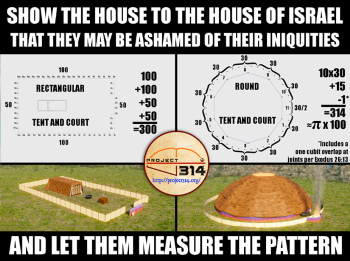
But to the contrary, Project 314 Tabernacle research and conclusions are based upon very literal application and strict adherence to the Hebrew texts–as understood from very traditional and widely accepted resources. To be more specific, the original Round Tabernacle exegesis is based upon familiar lexicons, including Strong’s concordance, Concordant Hebrew English Sublinear text (based on Wigram's Englishman's Concordance), Brown-Driver-Briggs Lexicon, and Geseneus’ Hebrew Grammar. In addition, “Edenics” (i.e., the notion that ancient Hebrew word meanings have been preserved via post-Babel languages to this day to various extents) and my understanding to Modern Hebrew have likewise been useful in several isolated cases where academic and traditional Biblical Hebrew resources are found to be presumptive, unintelligent, or lacking precedent throughout the entire Hebrew Tanakh compilation.
Apart from being attentive to Hebrew language specifics, engineering training—which instills a measure of mental discipline, systematic analysis, and attention to detail—also proved to be useful in deciphering the structure’s true nature. After all, the Exodus text reads a little like an engineering specification or bill of materials, which typically identify material types, quantities, lengths, weights, and functions. A familiarity with tents is also a “plus”. It should be noted, however, an engineering degree is not a prerequisite for arriving at the round Tabernacle design from the Hebrew exegesis. After all, all that is really required is a good attention span, deductive reasoning capability, some mechanical or technical aptitude, as well as good visualization skills. Few or none of these attributes or disciplines, mind you, can be honestly attributed to most proponents of the traditional models. After all, careful examination of rectangular Tabernacle models will typically reveal how a lack of discipline, along with an indifference to technical details and linguistic nuances of the Hebrew texts, has resulted in the design of God’s dwelling place being misrepresented—and virtually entombed in translations for thousands of years.
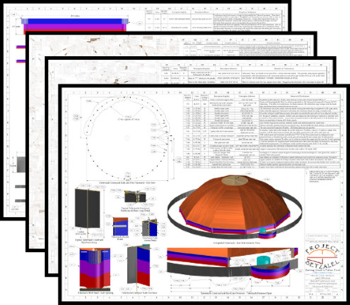
Fortunately, by applying common sense, basic engineering principles, and literally adhering to Hebrew Exodus texts, I was able to prove the round Hebrew Tabernacle hypothesis to not only be viable, but really unapologetically and exclusively correct in just a few short weeks. In contrast, any serious and objective engineer will be forced to admit that the traditional rectangular model makes awful sense—or no sense—given the numerous technical problems and unresolved details when the Bible text is rendered in a “traditional” way, that is, with God’s dwelling place resembling a crude shoebox.
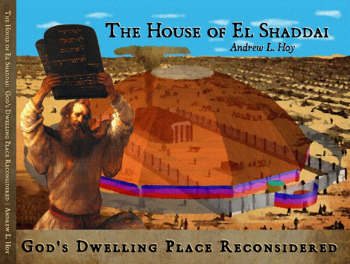
Although substantiating the majority of the round exegesis-based Hebrew Tabernacle claims remains outside the scope of this article, a few Hebrew-centric distinctions of the text are explored herein, as they are shown to be related to some of Jeff’s AHRC work. Interested parties are encouraged to further explore the round Tabernacle arrangement and exegesis as documented in my book (The House of El Shaddai—God’s Dwelling Place Reconsidered) or my original Exodus Engineering Exegesis drawing set.
Finding Assumptions, Bias, and Omissions in Tradition and Translation
As indicated above, traditional religious artwork and Bible translations alike have been highly influential in shaping perceptions of God’s dwelling place—especially for native English speakers. Interpreting the texts with numerous preconceived biases, scholars generally find themselves compelled, perhaps even subconsciously, to convey their biases within their translations of the Hebrew Bible. After all, they are tasked with creating an English narrative that reads coherently and sounds viable, which means that their own preconceptions and understandings will not only be incorporated, but will naturally take precedence over literal rendering of the Hebrew texts—even if the interjection of personal biases cannot be reconciled with original ancient language. In other words, given a “bias-over-literal rendering approach” to translation, the Hebrew text is butchered, twisted, and stretched in many places apart from the original revelation such that the English Bible rendering is made to sound coherent.
Moreover, apart from interjecting translation bias, the relative uniqueness of some of the Hebrew words used to describe mechanical or physical things in the Exodus Tabernacle account can also result in additional complications. Naturally, the handful of enigmatic language problems become exacerbated as incorrect paradigms are assumed, especially where as traditional rectangular model advocates do not all agree on the same paradigms. Consequentially, translations of mixed quality are produced. To be more specific, I have observed places and cases where some of the Hebrew is a) properly/reasonably translated, b) incorrectly/nonsensically translated deliberately as a result of bias (marked by obvious twisting of language), and c) incorrectly/nonsensically translated in ignorance and seemingly irrespective of preconceived paradigms (typically characterized by omission of detail and resulting in the loss of information). While the texts are mistranslated in many places and in different ways, it was initially a challenge to distinguish between these three cases of mistranslation, especially before making all of the paradigm shifts necessary to discern the proper round Tabernacle arrangement. After all, I began my study of the Exodus texts as perhaps anyone else would—by assuming that the ancient Hebrew Bible texts were originally translated by “expert” linguists possessing not only a great deal of reverence for the original divine revelation, but also endowed with more knowledge, wisdom, and discernment than I might be inclined to attribute to myself.
Coverings, Tents, and Tabernacles: Ancient Hebrew Language Confusion
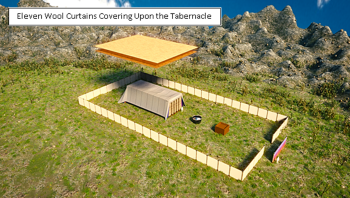
While exploring the Tabernacle narratives, one of the most essential paradigm shifts was made possible by carefully scrutinizing the Hebrew texts describing the eleven curtains in Exodus 26:7-13. Traditionally assumed to form the second layer of what is assumed to be a four-layered tent roof, I came to understand that the eleven wool curtains were instead intended to form an outer Tabernacle courtyard perimeter barrier. Confusion about the material purpose and appropriate is made evident in translation, as traditional Jewish and Christian interpreters typically render the first verse of the text as:
And thou shalt make curtains of goats' hair to be a covering upon the tabernacle: eleven curtains shalt thou make. – Exodus 26:7 (KJV)
However, “to be a covering upon the tabernacle” isn’t quite what the Bible language says. First of all, the passive English “be” verb, which is perhaps most often conveyed by the active Hebrew verb היה, meaning to “exist”, is not found in the original Exodus 26:7 text, as shown by color-coded corollary Hebrew text below:

In addition to interjecting the passive “be” verb, the translations generally add an indefinite article (like the “a” inserted into the English Exodus 26:7 text before “covering”), which denotes a singular common noun. In so doing, the ![]() text is assumed to be referring to a noun (i.e., to be a covering), as opposed to being interpreted as a simple verb, “to cover”, even though the remaining Hebrew אהל term (after the Hebrew preposition ל, meaning “to” or “for”) can be used as either a noun [Strong’s H168] or a verb [Strong’s H166 & H167].
text is assumed to be referring to a noun (i.e., to be a covering), as opposed to being interpreted as a simple verb, “to cover”, even though the remaining Hebrew אהל term (after the Hebrew preposition ל, meaning “to” or “for”) can be used as either a noun [Strong’s H168] or a verb [Strong’s H166 & H167].
To further complicate matters, in the most literal rendering of the Hebrew, the word אהל (H168) is not normally translated as “cover” (it appears as “cover” in the KJV in but 1 out of 345 occurrences), but is predominantly translated as “tabernacle” or “tent”, with  therefore literally conveying the idea of “to tent” instead of “to cover” or “to be a covering”. Moreover, the English translation becomes even more confusing when interpreters translate two entirely different Hebrew words (אהל and משׁכן, ohel and mishkan, H168 and H4908), by using the exact same English tabernacle word. In the case of Exodus 26:7, this translation trend and nuance is especially problematic, as the two different Hebrew words are used in such close proximity in the same sentence. Specifically, to say “to tabernacle upon the tabernacle” is as nonsensical as “to tent upon the tabernacle” is enigmatic; and such convoluted language might help explain why translators seem to desperately resort to linguistic gymnastics in creating the accepted English “to be a covering” translation.
therefore literally conveying the idea of “to tent” instead of “to cover” or “to be a covering”. Moreover, the English translation becomes even more confusing when interpreters translate two entirely different Hebrew words (אהל and משׁכן, ohel and mishkan, H168 and H4908), by using the exact same English tabernacle word. In the case of Exodus 26:7, this translation trend and nuance is especially problematic, as the two different Hebrew words are used in such close proximity in the same sentence. Specifically, to say “to tabernacle upon the tabernacle” is as nonsensical as “to tent upon the tabernacle” is enigmatic; and such convoluted language might help explain why translators seem to desperately resort to linguistic gymnastics in creating the accepted English “to be a covering” translation.
Obviously, connotations and contexts have a way of dictating vocabulary usage and shaping our thinking; and such distinctions are of critical importance in translation, especially as there are not always direct English equivalents for Hebrew words. For example, in English, “cover”, “tent”, and “tabernacle” terms are each used distinctly different. We might expect to find a “cover” sealing a glass jar, but would not likely refer to that round cap as a “tent” or a “tabernacle”. Likewise, if someone goes camping, they would bring a “tent” and not a “cover” or “tabernacle” to sleep in or beneath. In contrast, “tabernacle” or “Tabernacle” tends to be used solely in religious contexts. People might name a church or a synagogue with the “Tabernacle” term in the title in reference to the Exodus dwelling place (e.g., the Mormon “Tabernacle” choir), but would not consider incorporating the “tent” or “cover” term in the title or using the terms interchangeably, even though all buildings naturally employ some sort of covering overhead. Ironically, these modern religious facilities with “Tabernacle” in the namesake are generally of brick-and-mortar construction, whereas the ancient “Tabernacle” is known only as a wood and fabric tent. Of course, these three nouns can also be uniquely used as verbs, thus underscoring the complexity and importance of word selection in translation.
All that being said, how are the Hebrew אהל and משׁכן terms to be distinguished in English, or more specifically, how is the  phrase, to be understood? Based upon usage,
phrase, to be understood? Based upon usage,  is predominantly translated as “the tabernacle” (a.k.a. the unique “Tent of Meeting”) throughout the Bible. Also, with the Hebrew definite article ה or “the” preceding “tabernacle”, it stands to reason that it might be regarded as a proper noun, perhaps best rendered as “the Tabernacle”. However, this is not to say that “Tabernacle” is a good choice of words in translation, either. After all, the Latin root “Taberna”, from which “Tabernacle” (and the English “Tavern”) is derived, is often used to describe shack or hut, even though the Hebrew משׁכן or “mishkan” term (from H7931) is more literally rooted in the action of dwelling or residing and therefore is a term that is not associated with a particular construction style. Thus, a “mishkan” is best understood in English vernacular more generically, as a residence or a dwelling place, especially as the term “Tabernacle” is practically never used in everyday conversation unless the term is coupled to something that is religious in nature. Taken literally, the Hebrew
is predominantly translated as “the tabernacle” (a.k.a. the unique “Tent of Meeting”) throughout the Bible. Also, with the Hebrew definite article ה or “the” preceding “tabernacle”, it stands to reason that it might be regarded as a proper noun, perhaps best rendered as “the Tabernacle”. However, this is not to say that “Tabernacle” is a good choice of words in translation, either. After all, the Latin root “Taberna”, from which “Tabernacle” (and the English “Tavern”) is derived, is often used to describe shack or hut, even though the Hebrew משׁכן or “mishkan” term (from H7931) is more literally rooted in the action of dwelling or residing and therefore is a term that is not associated with a particular construction style. Thus, a “mishkan” is best understood in English vernacular more generically, as a residence or a dwelling place, especially as the term “Tabernacle” is practically never used in everyday conversation unless the term is coupled to something that is religious in nature. Taken literally, the Hebrew  or “the Mishkan” is referring not to “a shack”, but rather a particular dwelling place.
or “the Mishkan” is referring not to “a shack”, but rather a particular dwelling place.

As for the preceding  phrase, given the confusion imposed by translators upon “cover”, “tent”, and “tabernacle” usages, it is most fitting to consider the אהל term relative to physical descriptions of the curtains themselves. As illustrated in the round Tabernacle image below, the eleven wool curtain strips measuring 30 x 4 cubits are all designed to be connected short-edge-to-short edge, and are equipped with loops on opposite ends, with one curtain folded in half, and collectively overlapping one cubit. From this description, as well as from the math, the audience should understand that the final shape will be cylindrical (because all curtains must connect to an adjacent one to comply with the Bible description), and because the final circumferential dimensions measure 314 cubits—which is a clear and obvious hint of π. Understanding that the curtain assembly would logically be assembled on by people bound by gravity to a horizontal ground plane, deductive reasoning dictates that the curtains “over” or על the dwelling place would more specifically be installed “around” the dwelling place, especially as the dwelling place itself is formed in part by an assembly of ten colored linen curtains, each measuring only 28 x 4 cubits (Exodus 26:1), which would obviously create a smaller tent perimeter.
phrase, given the confusion imposed by translators upon “cover”, “tent”, and “tabernacle” usages, it is most fitting to consider the אהל term relative to physical descriptions of the curtains themselves. As illustrated in the round Tabernacle image below, the eleven wool curtain strips measuring 30 x 4 cubits are all designed to be connected short-edge-to-short edge, and are equipped with loops on opposite ends, with one curtain folded in half, and collectively overlapping one cubit. From this description, as well as from the math, the audience should understand that the final shape will be cylindrical (because all curtains must connect to an adjacent one to comply with the Bible description), and because the final circumferential dimensions measure 314 cubits—which is a clear and obvious hint of π. Understanding that the curtain assembly would logically be assembled on by people bound by gravity to a horizontal ground plane, deductive reasoning dictates that the curtains “over” or על the dwelling place would more specifically be installed “around” the dwelling place, especially as the dwelling place itself is formed in part by an assembly of ten colored linen curtains, each measuring only 28 x 4 cubits (Exodus 26:1), which would obviously create a smaller tent perimeter.
Likewise, to infer that על, which is reasonably translated as “upon”, conveys that the tent is situated “up-on” (i.e., “above” or “on top of”) the dwelling place is presumptive as it is illogical, especially if the curtains are “to cover” or “to tent” over the residence. After all, the Hebrew preposition על for “over” or “upon” works much like the English counterparts, whereby they are not necessarily describing a relative elevation or vertical relationship, but rather a relative positioning. For example, a shirt worn “over” the body is not worn on top of the head as a hat, as the shirt is designed to surround and encompass. Furthermore, this notion of the wool curtains forming a vertical courtyard barrier at ground level is further reinforced by the Hebrew reference to על צדי המשכן in Exodus 26:13, which distinctly indicates that the eleven curtains are to be installed “over/around the Tabernacle side”, as opposed to “over/upon the Tabernacle top”.
Unfortunately, a modern Englishman is unlikely to literally think of using a vertical fence or court barricade as  or “to tent over” an area or structure—especially if the structure within the fence is a giant tent or other residence, and especially as English “tents” are always presumed to have roofs, which is not the case for the Hebrew אהל term (recalling that KJV translators rendered it as “cover” instead of “tent”). However, regardless of our Western sense of entitlement, there is no assurance of a direct word-for-word equivalent in Hebrew-to-English translations. Thus, by deductive reasoning, a more practical and logical translation might read:
or “to tent over” an area or structure—especially if the structure within the fence is a giant tent or other residence, and especially as English “tents” are always presumed to have roofs, which is not the case for the Hebrew אהל term (recalling that KJV translators rendered it as “cover” instead of “tent”). However, regardless of our Western sense of entitlement, there is no assurance of a direct word-for-word equivalent in Hebrew-to-English translations. Thus, by deductive reasoning, a more practical and logical translation might read:
“And thou shalt make curtains of goats' hair to tent around the dwelling place: eleven curtains shalt thou make.”—Exodus 26:7 (Modified KJV)
For those hoping to avoid being led astray by translator bias, such as that made evident by just three Hebrew words as identified above, I always recommend tools such as interlinear Bibles (or Jeff’s mechanical Torah translation). Although the English presentation of the ideas may appear to be jumbled out of sequence or inconsistent with awkward grammar or syntax, the translations are kept short and to the point, and the literal meanings of the original texts are better preserved as there is less latitude for individual bias and tampering. Consider the AHRC mechanical translation of the same Exodus verse below:
and~you(ms)~did~DO TENT-WALL~s SHE-GOAT~s to~TENT UPON the~DWELLING ONE TEN TENT-WALL~s you(ms)~will~DO AT~them(m) – Exodus 26:7 (AHRC-MT)
What is a Hebrew “Tent”?
Although a combination of deductive reasoning and diligent examination of the simple or “pashat” Bible texts by means of conventional Hebrew lexicons and resources enabled me to rediscover the lost Tabernacle, I was nevertheless amazed at how Jeff’s pictograph alphabet research was able to affirm my own conclusions on numerous occasions throughout the project—revealing details in ways that the plain Aramaic Hebrew-based texts and resources could not.
One such case of paleo affirmation was with this Hebrew אהל or “tent” term. Contrary to English usage, and as demonstrated by the rearrangement of the wool curtain set above, the Hebrew “tent” need not have a roof. While I struggled with this idea and drastic paradigm shift at the onset of my research, I recall hearing a lecture by Rabbi Jonathan Sacks (chief Rabbi of England) making this very point—that a tent is a barrier that can consist of walls, but is not obligated to include an overhead roof. Strangely enough, the Hebrew אהל term, which appears as  when presented in the more ancient pictorial form (AHRC Early Semetic script font), conveys this very idea (refer to characters and descriptions in AHRC chart on the first page of the article). In context, the same Exodus verse expressed exclusively with ancient Hebrew alphabet letters presents as follows:
when presented in the more ancient pictorial form (AHRC Early Semetic script font), conveys this very idea (refer to characters and descriptions in AHRC chart on the first page of the article). In context, the same Exodus verse expressed exclusively with ancient Hebrew alphabet letters presents as follows:


Cryptic as it might first look, the phrase “to tent” or  is
is  > in the ancient pictorial system. Dissecting this word-picture text, we see two sticks or staffs (
> in the ancient pictorial system. Dissecting this word-picture text, we see two sticks or staffs ( ) bounding an “aleph”—the head of an ox (
) bounding an “aleph”—the head of an ox ( ), which is representative of strength or a beginning, along with the ancient “hey” letter—a man elevating two hands high in the air (
), which is representative of strength or a beginning, along with the ancient “hey” letter—a man elevating two hands high in the air ( ). This spelling or pattern of letters is interesting, as the courtyard boundary (Exodus 26:7-13) is created by a strong wool fabric barrier (the word for wool or עזים used in Exodus 26:7 comes from the root עזז meaning “strong”), with strength being symbolized or expressed in a single letter (
). This spelling or pattern of letters is interesting, as the courtyard boundary (Exodus 26:7-13) is created by a strong wool fabric barrier (the word for wool or עזים used in Exodus 26:7 comes from the root עזז meaning “strong”), with strength being symbolized or expressed in a single letter ( ), as indicated on the AHRC chart. To the outsider, this wool curtain courtyard is the first thing that is encountered, just like aleph is the first letter of the aleph-bet. Apart from the idea of strength or beginning, there is also the action of praise, which took place around the Tabernacle, and is conveyed by the Hebrew letter “hey” or (
), as indicated on the AHRC chart. To the outsider, this wool curtain courtyard is the first thing that is encountered, just like aleph is the first letter of the aleph-bet. Apart from the idea of strength or beginning, there is also the action of praise, which took place around the Tabernacle, and is conveyed by the Hebrew letter “hey” or ( ). Also, this “hey” letter might be associated with the action of elevating of both the strong wool and the sticks, with two sticks represented by the Hebrew lamed (
). Also, this “hey” letter might be associated with the action of elevating of both the strong wool and the sticks, with two sticks represented by the Hebrew lamed ( ), which further resemble two uplifted arms.
), which further resemble two uplifted arms.
While an astute reader might realize that there are no physical sticks ( ) listed in Exodus 26:7-13 texts—which are needed both physically and linguistically to make a Hebrew tent—the same powers of observation might cause a reader to note that there are no dimensional details given for courtyard fabrics as mentioned in Exodus 27:9-19. In other words, upon closer examination, the reader will find that Exodus 26 refers to strong fabrics that must inherently be slung by “sticks” to make a tent, whereas Exodus 27 later describes the “sticks” that are in turn used for slinging the strong fabrics.
) listed in Exodus 26:7-13 texts—which are needed both physically and linguistically to make a Hebrew tent—the same powers of observation might cause a reader to note that there are no dimensional details given for courtyard fabrics as mentioned in Exodus 27:9-19. In other words, upon closer examination, the reader will find that Exodus 26 refers to strong fabrics that must inherently be slung by “sticks” to make a tent, whereas Exodus 27 later describes the “sticks” that are in turn used for slinging the strong fabrics.
From my experience, I regret to say that this “to tent” or  or
or  example is perhaps among some of the least compelling of all ancient Hebrew picture language examples that I have encountered in my Tabernacle studies, even though it was useful in affirming the notion that the wool curtains were used to create a tent consisting of walls but no roof. Nevertheless, the “strong raised sticked wall” term was showcased because not only because it is germane to the round “tent” discovery of Exodus 26:7-13 that has been explained in some detail above, but because perceiving many of the ancient pictorial aleph-bet letters and terms in the Tabernacle contexts are contingent upon a more thorough understanding of the hardware arrangement, as will be made further evident in the next example.
example is perhaps among some of the least compelling of all ancient Hebrew picture language examples that I have encountered in my Tabernacle studies, even though it was useful in affirming the notion that the wool curtains were used to create a tent consisting of walls but no roof. Nevertheless, the “strong raised sticked wall” term was showcased because not only because it is germane to the round “tent” discovery of Exodus 26:7-13 that has been explained in some detail above, but because perceiving many of the ancient pictorial aleph-bet letters and terms in the Tabernacle contexts are contingent upon a more thorough understanding of the hardware arrangement, as will be made further evident in the next example.
Clothing the Tent “Shoulders”
As the reader is unlikely to be familiar with many aspects of the round Hebrew Exodus Tabernacle, it is particularly impractical to offer extensive proofs and ancient Hebrew pictorial language examples using the Tabernacle’s interior, overall configuration, or individual hardware nuances. However, as the courtyard curtains have been introduced and as the courtyard frame has been mentioned, it is particularly appropriate to explain the curious use of the Hebrew term כתף.
Typically, the Hebrew term כתף is represented as  using the ancient pictorial letters and most literally translated as “shoulder”. By now, it should come as no surprise to suggest that the interpreters have warped the Tabernacle courtyard description while translating it into the English Exodus. For comparison, the color-coded English is placed next to Aramaic and Semetic Hebrew citations of the same text:
using the ancient pictorial letters and most literally translated as “shoulder”. By now, it should come as no surprise to suggest that the interpreters have warped the Tabernacle courtyard description while translating it into the English Exodus. For comparison, the color-coded English is placed next to Aramaic and Semetic Hebrew citations of the same text:


As the text continues describing courtyard anatomy, it is of particular note that all magenta text that is flagged in the English translation above has no literal or direct correlation in the original Hebrew verse. As serious English Bible aficionados know, words that are presented in white italics in the King James are understood to be added for continuity of thought based on translator inference. In this case, the word for “gate” is one such term—there is no mention of the word in Hebrew in Exodus 27:14 or 15. Nevertheless, with inference and eisegesis driving the translation, courtyard configuration and dimensional data are assumed to be interpreted in accordance with the rest of the rectangular paradigm, as shown in the adjacent rectangular Tabernacle picture.
Apart from the italicized baggage cluttering up the translations, there is again a particular problem with the translator’s choice of words. In particular, is translated as “side”. While this is not an isolated occurrence (כתף is rendered as “side[s]” in the King James Bible 34 of 67 times), this “side” term fails to capture the primary or principle ideas as conveyed in the Strong’s concordance.
Strong’s H3802 (כתף): From an unused root meaning to clothe; the shoulder (proper, that is, upper end of the arm; as being the spot where the garments hang); figuratively side piece or lateral projection or anything: - arm, corner, shoulder (-piece), side, undersetter.
Although “side” is permitted by the כתף concordance definition, this is not to say it is a good choice of words or remotely representative of the Moses’ instructions. For a point of reference, this wouldn’t be the first time that translators have generically translated more particular Hebrew terms into the word “side”. In fact, at least 20 other Hebrew words have on some occasion been translated into the KJV as “side” (חגר, חוף, ימין, ירך, זה, כה, כתף, מזרח, מתן, סבב, עבר, פאה, צד, צלע, קדם, קיר, רוח, שטר, שפה, תמן). This is especially ironic in the case of the Tabernacle narrative, as the English word “side” likely comes from the real Hebrew word צד which literally means “side” and similarly pronounced “tsad”. As previously discussed, this very צד word further speaks to the traditional misappropriation of the wool curtains described in Exodus 26:7-13, as verse 13 uses the word for “side” as it describes the wool curtains which are to be “stretched over (or around) the sides of the Tabernacle”. Nevertheless, the relatively vague English “side” word, which is mostly used to define a relative location when used to describe objects, is used instead of “shoulder” and to the shame of King James translators in Exodus 27:14-15.
By understanding that verse 14 and 15 are a continuation of a larger and comprehensive courtyard description which began in verse 9, accepting that “to clothe” or “to shoulder” is a more accurate representation of  , and seeing that the wrong prepositions are used (of and on are used in place of to or for), a more literal translation of the Hebrew is as follows:
, and seeing that the wrong prepositions are used (of and on are used in place of to or for), a more literal translation of the Hebrew is as follows:
And fifteen cubit hangings to clothe their posts, three; and their controllers, three; and to clothe the second, fifteen (cubit) hangings, their posts three, and their controllers three. – Exodus 27:14-15
Or, perhaps more appropriately and literally:
And fifteen cubit hangings to shoulder their posts, three; and their controllers, three; and to shoulder the second, fifteen (cubit) hangings, their posts three, and their controllers three. – Exodus 27:14-15

Given that wool fabrics measuring 30 cubits long (from Exodus 26:7-13) were provided “to tent” or “for a tent” ( or
or  ), it should come as no surprise that Tabernacle courtyard fabrics were specified to be “clothed” or “shouldered” (
), it should come as no surprise that Tabernacle courtyard fabrics were specified to be “clothed” or “shouldered” ( or
or  ) using two 15 cubit stick-like frame sections. Understanding that the center post is one of five stick-like copper posts suspending the 30 cubit wool curtain, both the image and the Hebrew word picture formed begins to make more sense.
) using two 15 cubit stick-like frame sections. Understanding that the center post is one of five stick-like copper posts suspending the 30 cubit wool curtain, both the image and the Hebrew word picture formed begins to make more sense.

With respect to the “shoulder” as conveyed by ancient pictorial Hebrew  letters, we see that the letter “tav” is dividing the three letter word, which is drawn to resemble the crossing of sticks ת or (
letters, we see that the letter “tav” is dividing the three letter word, which is drawn to resemble the crossing of sticks ת or ( ). Strangely enough, the same can be said for the two shoulders or flanks, which are likewise divided by a center post that intersects with two horizontal rods (see above). Needless to say, the “tav” letter (
). Strangely enough, the same can be said for the two shoulders or flanks, which are likewise divided by a center post that intersects with two horizontal rods (see above). Needless to say, the “tav” letter ( ) also resembles a human torso with arms extended outward from the shoulder—perhaps corresponding with the “hey” letter (
) also resembles a human torso with arms extended outward from the shoulder—perhaps corresponding with the “hey” letter ( ), which is found in the Hebrew
), which is found in the Hebrew  word for “tent” and depicts arms raised in the air. As a garment is symmetrically slung over two human shoulders, the same might be said of this center tee junction, which slings the fabric curtain over the two arm-like rod extensions which extend in opposite directions from the center tee junction. As the courtyard curtain rod system employs a sort of silver “T” joint, it’s clear that the hardware used for the Tabernacle frame takes on a configuration and function similar to the human shoulder; hence the Hebrew Exodus language “to clothe” or “to shoulder” (Exodus 27:9 also speaks about court hardware as being used for “slings” for fabric).
word for “tent” and depicts arms raised in the air. As a garment is symmetrically slung over two human shoulders, the same might be said of this center tee junction, which slings the fabric curtain over the two arm-like rod extensions which extend in opposite directions from the center tee junction. As the courtyard curtain rod system employs a sort of silver “T” joint, it’s clear that the hardware used for the Tabernacle frame takes on a configuration and function similar to the human shoulder; hence the Hebrew Exodus language “to clothe” or “to shoulder” (Exodus 27:9 also speaks about court hardware as being used for “slings” for fabric).

Apart from “shouldering” fabric, the curved courtyard fence section also “cups” or “caphs” (spelled with the two outer ף and כ letters of כתף) the dwelling place in its hollow. Again, it is noteworthy that the ancient Hebrew “caph” כ or ( ) is related to a cupped human hand, which is comprised of five fingers (and perhaps also related to the “calf” of a leg). Considering that the single fabric section, consisting of two flanks, is held up by five posts (measuring three posts from the overlapping center post in both left and right directions), the section might also be likened unto the five fingers extending downward from the shoulder above.
) is related to a cupped human hand, which is comprised of five fingers (and perhaps also related to the “calf” of a leg). Considering that the single fabric section, consisting of two flanks, is held up by five posts (measuring three posts from the overlapping center post in both left and right directions), the section might also be likened unto the five fingers extending downward from the shoulder above.

Finally, there is “pey” or פ or ף, which is the ancient letter ( ). As shown on the AHRC chart, the Greek Pi or letter π comes from this Hebrew word, as it has been related to perimeter. Also, as indicated by the chart, the single Hebrew “pey” letter (
). As shown on the AHRC chart, the Greek Pi or letter π comes from this Hebrew word, as it has been related to perimeter. Also, as indicated by the chart, the single Hebrew “pey” letter ( ) is also understood to resemble a mouth or lips, which is consistent with the Hebrew description found in Exodus. Specifically, the courtyard frame is literally made “to edge”, “to mouth” or “to lip” the woven curtains to a given perimeter, as conveyed by לפאה or לפאת, according to Exodus 27:9 and 27:11. Thus, this single letter to full word corollary is similar to the relationship demonstrated by the single aleph (
) is also understood to resemble a mouth or lips, which is consistent with the Hebrew description found in Exodus. Specifically, the courtyard frame is literally made “to edge”, “to mouth” or “to lip” the woven curtains to a given perimeter, as conveyed by לפאה or לפאת, according to Exodus 27:9 and 27:11. Thus, this single letter to full word corollary is similar to the relationship demonstrated by the single aleph ( ) letter in the tent term as it related to the “strong wool” curtains—as the Hebrew terms עזים and עזז seem to convey.
) letter in the tent term as it related to the “strong wool” curtains—as the Hebrew terms עזים and עזז seem to convey.
In summary, the courtyard “shoulders”, as described by the Hebrew כתף or  , are like open and cupped hands (
, are like open and cupped hands ( ), formed by crossing rods (
), formed by crossing rods ( ), which are found at the outer lip or mouth (
), which are found at the outer lip or mouth ( ) of the Tabernacle facility. Even the final assembly of כתף seems to resemble a pair of shoulders as the building profile is viewed at eye level, with the shoulders being the outermost side extents protruding from the sides of the Tabernacle facility or complex. Likewise, it is interesting that the Hebrew tent word picture story is about strong (wool fabric) elevated by sticks, as told by
) of the Tabernacle facility. Even the final assembly of כתף seems to resemble a pair of shoulders as the building profile is viewed at eye level, with the shoulders being the outermost side extents protruding from the sides of the Tabernacle facility or complex. Likewise, it is interesting that the Hebrew tent word picture story is about strong (wool fabric) elevated by sticks, as told by  or
or  , not only adds another layer of dimension to the courtyard configuration, but also reads complementary to the story of the courtyard shoulders, as revealed by the Hebrew כתף or
, not only adds another layer of dimension to the courtyard configuration, but also reads complementary to the story of the courtyard shoulders, as revealed by the Hebrew כתף or  letter sequence. Keep in mind that these are but two Hebrew words, which make up a fraction of the Tabernacle puzzle and thus the mere beginning to the Ancient Hebrew Tabernacle story.
letter sequence. Keep in mind that these are but two Hebrew words, which make up a fraction of the Tabernacle puzzle and thus the mere beginning to the Ancient Hebrew Tabernacle story.
The Ancient Hebrew Alphabet and Tent Witnesses
After Jeff extended an invitation to write an article for his AHRC audience, I initially wasn’t sure what content I wanted to discuss. As such, I made a point to take a fresh look at the entire aleph-bet that Jeff has condensed to a single sheet. As I pondered the ancient pictorial alphabet, it suddenly struck me after overlooking the obvious for several years: It seems that every letter of the Ancient Hebrew alphabet is instrumental in telling the overall Tabernacle tale. Consider how every ancient Hebrew letter has some correlation to the ancient Tabernacle story:
- The letter ב or
 or “bet” was originally drawn to represent a tent floor plan.
or “bet” was originally drawn to represent a tent floor plan. - The letter ו or
 or “vav” is a picture of a tent peg.
or “vav” is a picture of a tent peg. - The letter ח or
 or “chet” depicts a tent wall.
or “chet” depicts a tent wall. - The letter ד or
 or “dalet” refers to a doorway, which a tent must have.
or “dalet” refers to a doorway, which a tent must have. - The letter ל or
 or “lamed” is a rod / shaft / stick, which are used to create the tent frame.
or “lamed” is a rod / shaft / stick, which are used to create the tent frame. - The letter ת or
 or “tav” is portrayed as crossed sticks, which give strength to the tent frame.
or “tav” is portrayed as crossed sticks, which give strength to the tent frame. - The letter פ or
 or “peh” resembles a lip or a mouth and alludes to the facility’s perimeter.
or “peh” resembles a lip or a mouth and alludes to the facility’s perimeter. - The letter כ or
 or “caph” is like an open/cupped hand, as the court is described (above).
or “caph” is like an open/cupped hand, as the court is described (above). - The letter ש or
 or “shin” portrays an opposing pair, as were the courtyard halves.
or “shin” portrays an opposing pair, as were the courtyard halves. - The letter ה or
 or “hey” conveys elevation (tent), praise (human), and inspiration (divine).
or “hey” conveys elevation (tent), praise (human), and inspiration (divine). - The letter ר or
 or “resh” or “rosh” is a head, which is what Exodus called the tent top.
or “resh” or “rosh” is a head, which is what Exodus called the tent top. - The letter ס or
 or “sameck” is tack/pin-like, as used for court posts and sting compass lines.
or “sameck” is tack/pin-like, as used for court posts and sting compass lines. - The letter מ or
 or “mem” is water, which is found in the basin next to the tent.
or “mem” is water, which is found in the basin next to the tent. - The letter ט or
 or “tet” is basket-like, as is the round copper altar at the gate of the court.
or “tet” is basket-like, as is the round copper altar at the gate of the court. - The letter ז or
 or “zayin” is a hatchet or blade, which is used for slaughter at the altar.
or “zayin” is a hatchet or blade, which is used for slaughter at the altar. - The letter נ or
 or “nun” is seed, which was offered (e.g., grain or first-fruits) at the altar.
or “nun” is seed, which was offered (e.g., grain or first-fruits) at the altar. - The letter י or
 or “yad” is drawn like a hand, which depicts work and worship.
or “yad” is drawn like a hand, which depicts work and worship. - The letter א or
 or “aleph” is the ox head, and oxen would be used to haul tent beams.
or “aleph” is the ox head, and oxen would be used to haul tent beams. - The letter צ or
 or “tzade” shows a wandering path, as were Israel’s journeys.
or “tzade” shows a wandering path, as were Israel’s journeys. - The letter ג or
 or “gimmel” is drawn like foot or camel, which are used by wandering nomads.
or “gimmel” is drawn like foot or camel, which are used by wandering nomads. - The letter ק or
 or “quf” is subdivided circle, common to sunrise, equinox, and the domed tent.
or “quf” is subdivided circle, common to sunrise, equinox, and the domed tent. - The letter ע or
 or “ayin” is where “eye” comes from, and the structure looks like an eyeball.
or “ayin” is where “eye” comes from, and the structure looks like an eyeball.
Clearly, the entire wilderness-desert-life experience can be seen in this remarkable aleph-bet language, and even two three letter words are able to tell part of the story. But this is only the beginning. What might the Tabernacle pattern and the ancient Hebrew alphabet reveal to you?

Like what you’re discovering? Continue the journey from Bible reader to translator.
|



